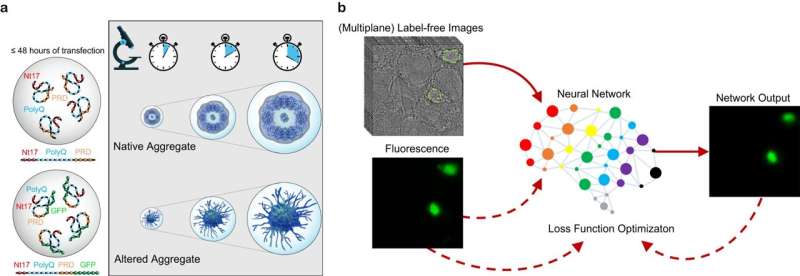This article has been reviewed according to Science X's editorial process and policies. Editors have highlighted the following attributes while ensuring the content's credibility:
fact-checked
peer-reviewed publication
trusted source
proofread
AI unlocks new insights in neurodegenerative disease research

Neurodegenerative diseases such as Alzheimer's, Parkinson's, and Huntington's, are a growing challenge in health care, affecting millions globally. They are characterized by a progressive decline in neural function and manifest in a range of debilitating symptoms. And as our lifespans increase, the incidence of neurodegenerative diseases increases with the aging global population.
Many neurodegenerative diseases involve the accumulation of misfolded protein aggregates, which are central in the development and progression of diseases such as Alzheimer's, Parkinson's, and Huntington's. But progress in understanding and treating these diseases is hampered by the current methods of labeling misfolding proteins with fluorescent tags.
These approaches are effective to a degree, but they also alter the proteins' biophysical properties, affecting how they interact with other proteins and cellular components. This makes it very difficult to accurately study the complexity and ultrastructural organization of the disease-causing protein aggregates in the brain.
Introducing LINA
Now, researchers from EPFL have developed a new technique that circumvents the issue by using deep learning to identify these aggregates without altering them, thus offering a non-invasive and highly accurate approach to understanding a central process in the pathogenesis of neurodegenerative diseases.
The new technique is called "Label-free Identification of Neurodegenerative-disease-associated Aggregates" (LINA) and was developed by the groups of Hilal Lashuel and Aleksandra Radenovic at EPFL's Schools of Life Sciences and Engineering respectively, with Kristin Grußmayer at TU Delft. The work is now published in Nature Communications.
LINA uses deep learning to analyze transmitted-light images from living cells, which allows it to identify protein aggregates without the use of fluorescent labeling. This method preserves the natural state of the proteins, providing high-fidelity data crucial for accurate research.
LINA on Huntington's
The scientists tested LINA in the context of Huntington's disease, a neurodegenerative disease that is caused by the misfolding of the protein Huntingtin. They used a well-controlled biological model system based on HEK 293 cells that overexpress mutant Huntingtin.
Using a custom-built, multi-modal, multi-plane microscope, the team captured ultrafast 4D brightfield and fluorescence images, which were transformed into images from quantitative phase imaging, or QPI. This is an imaging technique that captures the variations in light phase caused by a sample to "see" detailed information about its physical and optical properties, e.g., its thickness and refractive index, without the need for staining or labeling.
The researchers then used the QPI images as a foundation for training a convolutional neural network, which is an AI specifically designed for processing and analyzing visual data like images and videos.
The LINA technique showed remarkable accuracy in identifying aggregates formed by a fragment of the Huntingtin protein, known as Httex1. This fragment contains the site of mutations that cause Huntington's disease.
Lashuel explains, "Previous studies from our group showed that once Httex1 and other proteins linked to neurodegenerative diseases are fused to fluorescent proteins, they form aggregates that are very different from those seen for the native protein in neurons, which means that we are not able to reproduce and monitor the disease process."
LINA successfully identified Httex1 aggregates in both labeled and unlabeled proteins, demonstrating its versatility and consistency across various imaging conditions and cell lines.
LINA in live-cell imaging
The researchers used the AI to monitor the dynamic process of protein aggregation using live-cell imaging, providing new insights into the growth dynamics of Httex1 aggregates. This feature is vital for understanding the progression of neurodegenerative diseases and could potentially lead to the identification of new therapeutic targets.
But LINA proved to not just be effective in identifying protein aggregates; it can also carry out detailed comparisons between different types of them. Understanding these subtle differences and similarities is crucial, as it sheds light on how these protein aggregates form and behave, which is vital for understanding the progression of neurodegenerative diseases.
A simple, high-throughput, automated tool
"At its simplest form, our models present a simple and rapid method for automatically finding and segmenting protein aggregates from transmitted-light images, which can be either quantitative phase images or the simplest-possible brightfield images," says Khalid Ibrahim, the study's first author. "This provides users from labs around the world with an easy, high-throughput, automated technique to detect and analyze protein aggregates."
"We are now working to extend the application of this method to investigate the aggregation of other proteins linked to Alzheimer's and Parkinson's disease using novel and validated cellular models of these diseases," says Lashuel. "Our ultimate goal is to be able to capture early events in this process, which are thought to be major drivers of neurodegeneration, but remain inaccessible to most existing methods. This would pave the way to screen for new drugs to inhibit protein aggregation and toxicity."
Aleksandra Radenovic adds, "Being able to develop new methods that not only allow us to monitor the evolution of protein aggregation and pathology formation but also obtain quantitative measures on their properties could help us unmask new mechanisms and insights that are currently masked by the use of large fluorescent protein markers."
More information: Khalid A. Ibrahim et al, Label-free identification of protein aggregates using deep learning, Nature Communications (2023). DOI: 10.1038/s41467-023-43440-7


















